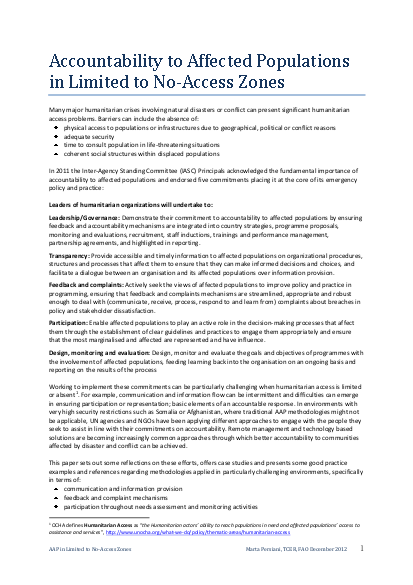
Many major humanitarian crises involving natural disasters or conflict can present significant humanitarian access problems. Barriers can include the absence of: physical access to populations or infrastructures due to geographical, political or conflict reasons adequate security time to consult population in life-threatening situations coherent social structures within displaced populations.
Transparency: Provide accessible and timely information to affected populations on organizational procedures, structures and processes that affect them to ensure that they can make informed decisions and choices, and facilitate a dialogue between an organisation and its affected populations over information provision.
Feedback and complaints: Actively seek the views of affected populations to improve policy and practice in programming, ensuring that feedback and complaints mechanisms are streamlined, appropriate and robust enough to deal with (communicate, receive, process, respond to and learn from) complaints about breaches in policy and stakeholder dissatisfaction.
Participation: Enable affected populations to play an active role in the decision-making processes that affect them through the establishment of clear guidelines and practices to engage them appropriately and ensure that the most marginalised and affected are represented and have influence.
Design, monitoring and evaluation: Design, monitor and evaluate the goals and objectives of programmes with the involvement of affected populations, feeding learning back into the organisation on an ongoing basis and reporting on the results of the process Working to implement these commitments can be particularly challenging when humanitarian access is limited or absent1. For example, communication and information flow can be intermittent and difficulties can emerge in ensuring participation or representation; basic elements of an accountable response. In environments with very high security restrictions such as Somalia or Afghanistan, where traditional AAP methodologies might not be applicable, UN agencies and NGOs have been applying different approaches to engage with the people they seek to assist in line with their commitments on accountability. Remote management and technology based solutions are becoming increasingly common approaches through which better accountability to communities affected by disaster and conflict can be achieved.
This paper sets out some reflections on these efforts, offers case studies and presents some good practice examples and references regarding methodologies applied in particularly challenging environments, specifically in terms of: communication and information provision feedback and complaint mechanisms participation throughout needs assessment and monitoring activities